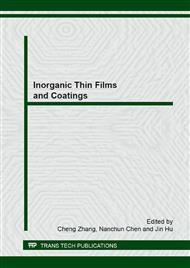p.87
p.92
p.97
p.101
p.105
p.109
p.114
p.118
p.122
Investigation on the Representation Method for Microwave Absorbing Coat
Abstract:
Based on the transmission line theory, influence factors of microwave absorbing ability for slab coat were analyzed and calculated. It was found that the parameter absorption rate could not effectively describe the different influence from material character, geometry dimension and microwave. As a solution, the matching property and absorption property needed to be discussed simultaneously. According to the new representation, matching property of coat depends only on the material character, whereas the absorbing ability resulted from the interaction between different interfaces within the sample. The influence of microwave frequency is reflected by interfere between different interfaces. Relatively, in the new representation, the influence from different factors was clear and intuition, which means the applicability of the new representation.
Info:
Periodical:
Pages:
105-108
Citation:
Online since:
January 2013
Authors:
Keywords:
Price:
Сopyright:
© 2013 Trans Tech Publications Ltd. All Rights Reserved
Share:
Citation:


